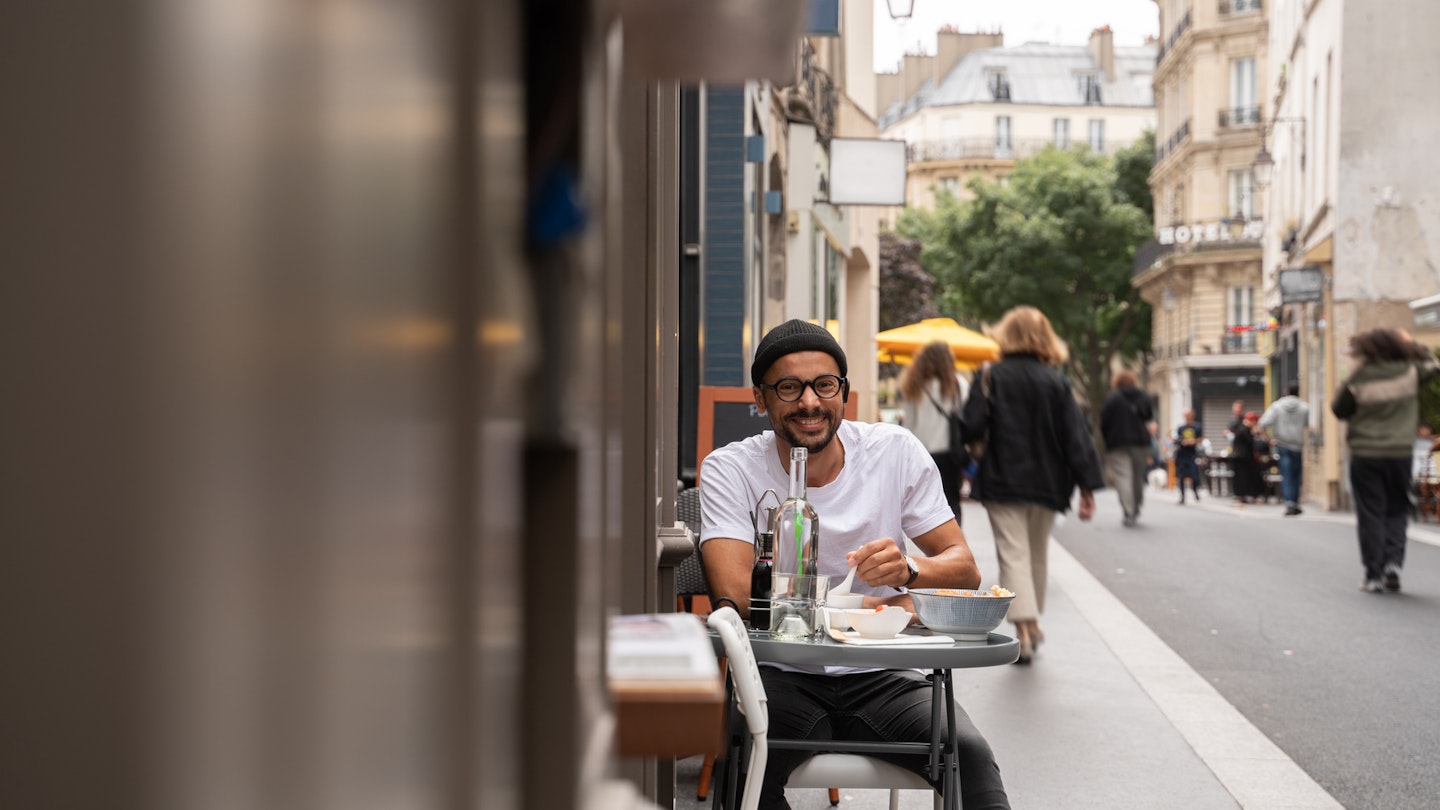Food is at the heart of daily life in France. Markets overflow with seasonal produce, gourmet shops are ubiquitous, farms and artisan producers often welcome visitors, festivals celebrate local specialties, and dining spans from street-food snacks to rustic meals to rarefied haute cuisine.
Above all, eating in France is about savoring the experience. Here’s our top 10 of the very best, connecting you to the land, culture, and traditions.
Soak up Lyon’s culinary heritage at a bouchon
Lyon is often dubbed France’s “gastronomic capital,” and you’ll see why when you visit a bouchon. These small, convivial bistros sprang up in the early 20th century, when wealthy households’ cooks, known as mères (mothers), set up their own homestyle premises with red-and-white-checked cloths covering closely packed tables.
Drawing on a thrifty nose-to-tail ethos, a classic bouchon meal might feature andouillette (pigs’ intestine sausages), boudin noir aux pommes (blood sausage with apples), pieds de mouton/veau/couchon (sheep/calf/pig trotters), tablier de sapeur (breaded, fried tripe) or quenelles de brochet (pike dumplings in crayfish sauce). After a cheese course like cervelle de canut (fromage blanc with chives and garlic), finish with tarte aux pralines, made with crushed pink candied almonds.
Unearth “black diamonds” in the Dordogne
In the Dordogne’s woodlands beneath oak and hazelnut trees, trained dogs sniff out elusive black Périgord truffles (Tuber melanosporum) that are traded at specialty markets during the midwinter season (December to mid-February) and star on local restaurant menus.
At the truffe (truffle) village of Sorges-et-Ligueux-en-Périgord, you can learn about the pungent fungi at the eco-museum and walk in the truffle-producing woods along the Sentier des Truffières.
Sample snails in Burgundy
The escargot de Bourgogne (Burgundy snail) frequented Burgundy’s monk-tended vineyards, becoming a staple during Lent. Today you can taste gastropod mollusks at specialty grocers in Burgundy’s “wine capital” Beaune and restaurants throughout the region.
Snails are cooked in a bouillon and presented in shells stuffed with parsley, garlic, and butter. Grasp the shells with special tongs and pry out the plump snails with a two-prong fork – then mop up the buttery puddle with chewy, freshly baked bread.
Slurp oysters in the Languedoc
Several coastal locales are celebrated for moules (mussels) and huîtres (oysters). A lesser-known gem is the little village of Bouzigues in southwestern France’s Languedoc region. Cruising aboard a boat, you can view the shellfish beds in the glinting Étang de Thau before enjoying them at waterside restaurants.
Warm up with melted cheese in the Alps
Lush alpine pastures provide the ideal environment for prized cheeses – including five AOP (Appellations d’Origines Protégées) and three IGP (Indications Géographiques Protégées) – that are sold at fruitières (traditional mountain cheesemongers) and central to Savoyard menus.
Hearty dishes include fondue savoyarde, dipping skewered bread chunks into a burner-warmed pot melding stringy cheeses such as Emmentaler, Beaufort, and Comté; raclette, “scraping” melting raclette cheese over boiled potatoes; and tartiflette, bubbling Reblochon cheese topping potatoes, lardons, onions, and crème fraîche.
Snack on street-food specialties in Nice
Nice’s seaside climate is ideal for grazing. Start in the atmospheric old town, Vieux Nice, where you’ll find the vibrant Cours Saleya food and flower market.
Stalls, shops, and tiny restaurants sell Niçoise specialties such as socca (chickpea-flour pancakes, served with pepper), tourte de blette (chard tart with raisins, pine nuts, and parmesan), pissaladière (caramelized onion and anchovy tart), and pan bagnat (crusty tuna sandwich with boiled eggs, black olives, and anchovies, drenched in green olive oil). Cool down with exceptional ice cream flavors, like olive, fig, and lavender.
Tuck in at Breton crêperies
Galettes and crêpes are a fixture of Brittany and its engaging former capital Nantes (now part of the Pays de la Loire region). These large, thin pancakes, expertly spread with a rozell (wooden rake) on a billig (cast-iron griddle), make an inexpensive, filling, and informal meal – albeit always served on plates and eaten with a knife and fork.
Begin with a savory galette, made using sarrasin or blé noir (buckwheat flour). The standard bearer is the galette complète with ham, cheese, and egg typically miroir (fried and placed sunny-side-up in the center). Follow it up with a sweet crêpe made with froment (wheat flour); the pick of the toppings is caramel beurre salé (sticky caramel made with salted Breton butter).
Devour pintxos in Biarritz
Encompassing southwestern France and neighboring northern Spain, the Basque Country is renowned for pintxos (Basque tapas), two-bite morsels balancing textures and flavors, often presented on small slices of baguette. Look out for creations featuring thinly sliced jambon de Bayonne (Bayonne ham), fiery-red Espelette chili peppers, and seafood such as anchovies, sardines, and calamari.
Feast on bouillabaisse in Marseille
Ancient Mediterranean port city Marseille is famed for its fish stew of humble beginnings, now a high-end specialty. Once a way for fisherfolk to cook up scraps left over from their catch, today bouillabaisse’s secret is the quality of the fish – served with a flavorful broth.
Vegetarians and vegans
Although France’s long-standing culinary traditions once meant few options for vegetarians and vegans, things have improved considerably in recent years. In larger towns, tourist centers, and cities such as Paris and Lyon, dedicated vegetarian and vegan establishments are on the rise, producing innovative plant-based dishes.
In rural areas, however, vegetarian and especially vegan cuisine can be limited – planning ahead is advisable. Some local specialties can be brilliant for vegetarians, while Nice’s specialty socca (chickpea-flour pancake) is a vegan favorite.
A year in food
Feasting happens year-round in France, and what’s cook varies with the seasons.
Spring (March–May)
Markets burst with asparagus, artichokes, and fresh goat’s cheese, with Easter featuring traditional lamb meals and sweet strawberries.
Summer (June–August)
Melons, cherries, peaches, apricots, figs, garlic, and tomatoes brighten markets. Seafood lovers will revel in coastal delights.
Autumn (September–November)
Harvest time brings nutty red rice and cider-producing apples from Normandy, alongside mushrooming and game seasons.
Winter (December–February)
The festive season in Provence and Corsica means Champagne and oysters, while the Alps feature traditional cheese fondue.





